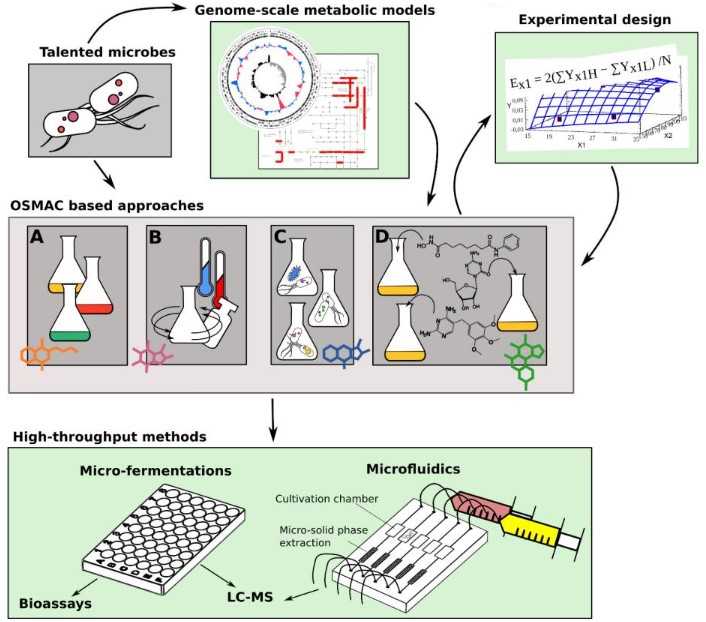OMSAC refers to one strain of many compounds. With the development of high-throughput sequencing technology, more and more fungal genomes are being uncovered. However, the number of fungal gene clusters encoding natural products has been much larger than the number of natural products identified from them, and there are many silent gene clusters in the fungal genome. Activating silent gene clusters in fungal genomes may lead to new natural products. Applying natural products have supported progress in areas such as agriculture and industry. Lifeasible can use the one strain many compounds approach to activate silent fungal gene clusters, leading to the discovery of novel bioactive natural products.
 Figure 1. Overview of the "one strain many compounds" based approaches to elicit production of cryptic secondary metabolites. (He B, et al., 2018)
Figure 1. Overview of the "one strain many compounds" based approaches to elicit production of cryptic secondary metabolites. (He B, et al., 2018)
The central idea of the One Strain, Many Compounds approaches, is that each strain is capable of producing multiple compounds. Yet, only specific compounds can be produced under specific culture conditions. Therefore, we can induce the expression of silent genes and trigger the production of new compounds by changing the culture conditions of the fungus. We can analyze the parameters of the culture conditions that induce the expression of fungal silencing gene clusters and identify the newly produced secondary metabolites by mass spectrometry.
The easiest and most direct way to obtain diverse secondary metabolites from the same strain is to use different culture media. However, the diversity of variation in fungal culture parameters makes the activation of silent gene clusters by the OSMAC method both time-consuming and complex. We can help our customers analyze the impact of variation in fungal culture parameters on secondary metabolite production, allowing them to determine the specific method of OSMAC-mediated silent gene cluster activation in the shortest possible time. The specific fungal culture conditions we can analyze are as follows. Including but not limited to:
| Carbon Source | Glucose | Nitrogen source | Ammonium citrate |
| Galactose | Ammonium nitrate | ||
| Arabinose | Ammonium sulfate | ||
| Fructose | Monosodium glutamate | ||
| Glycerol | Potassium nitrate | ||
| Lactose | Sodium nitrate | ||
| Maltose | Alanine | ||
| Mannitol | Arginine | ||
| Mannose | Asparagine | ||
| Meso-inositol | Aspartic acid | ||
| Rhamnose | Glutamic acid | ||
| Starch | Hydroxyproline | ||
| Sucrose | Leucine | ||
| Xylose | Methionine | ||
| Phenylalanine | |||
| Serine | |||
| Threonine | |||
| Tryptophan | |||
| Tyrosine |
The addition of a certain amount of metal ions to the culture medium also causes changes in the metabolites of the target strain. Metal ions can alter the strain's metabolites by affecting its physiological structure and enzyme function. We can help our customers analyze the effects of metal ions on the secondary metabolites of fungi. The specific metal ions we can analyze include, but are not limited to:
| Lanthanum | Lutetium | Scandium |
| Yttrium | Cranium | Iron |
| Zinc | Copper | calcium |
| Molybdenum | Cobalt | Manganese |
Changes in culture conditions such as temperature, pH, and dissolved oxygen levels also affect the production of fungal secondary metabolites. We can help our customers design reasonable experiments to screen the culture conditions affecting fungal secondary metabolites' production.
Lifeasible can analyze the effects of nutrient regimes, metal ions, and culture conditions on the production of fungal secondary metabolites based on the OSMAC method. As your trusted partner, we can meet your fungal phylogenetic analysis needs and provide you with efficient, high-quality services. If you want to know the details, please contact us.Reference